Do DIY Ferret Cages Offer a Good Alternative?
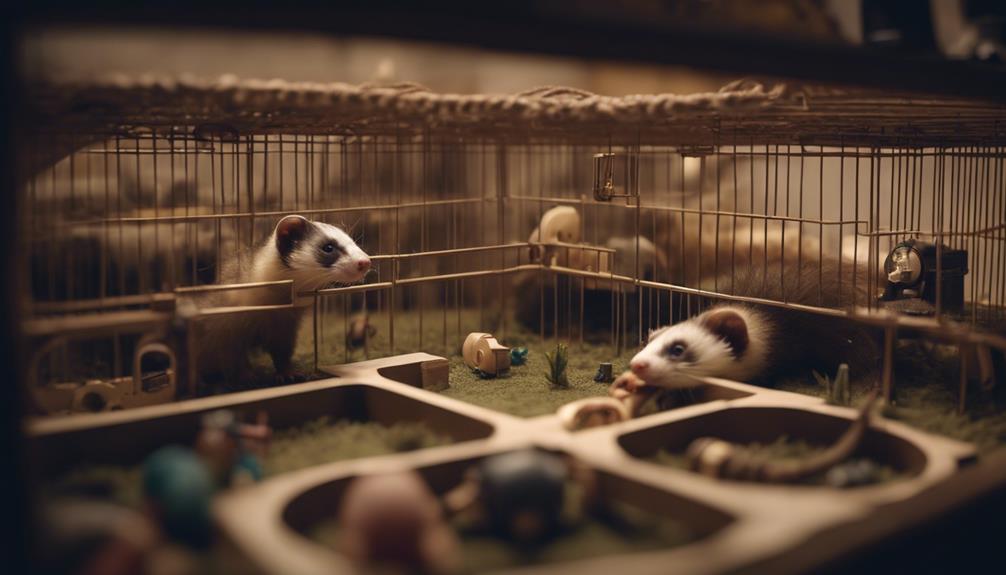
When considering DIY ferret cages, there are several factors to weigh. One advantage is the ability to customize the cage to suit your ferret's specific needs and your home's layout. This customization can lead to a more enriched environment for your ferret. However, DIY cages may not always meet the standards required for a safe and secure ferret habitat. Additionally, building your own cage can be time-consuming and may not always be cost-effective in comparison to purchasing a pre-made cage. Ultimately, the decision to go DIY with a ferret cage depends on your skills, resources, and the specific needs of your ferret.
Pros:
- Customizable to suit your ferret's needs
- Potential for a more enriched environment
- Opportunity for a fun DIY project
Cons:
- May not meet safety and security standards
- Time-consuming to build
- Cost may not be significantly lower than purchasing a pre-made cage
Cost Considerations
When considering the cost of DIY ferret cages, it's essential to weigh the expenses of materials and tools against the potential savings compared to store-bought cages. Budget-friendly options are abundant in the realm of DIY ferret cages. By utilizing DIY tricks such as repurposing old furniture or using cost-effective materials like PVC pipes and wire mesh, ferret owners can significantly reduce their expenses while still providing a safe and comfortable environment for their pets.
Space-saving solutions and creative designs play a vital role in maximizing the utility of a DIY ferret cage. Many DIY enthusiasts have come up with innovative layouts that not only save space but also provide enriching environments for ferrets to explore and play in. By customizing the cage's layout to fit the available space and the ferret's needs, owners can ensure that their pets have ample room to exercise and rest comfortably.
Space Customization Options
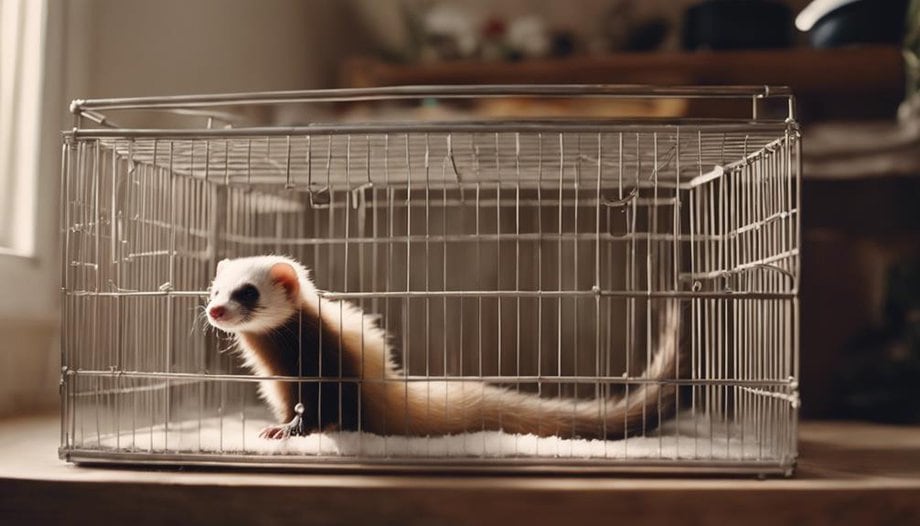
Ferret owners have the advantage of tailoring cage sizes to suit their pets' needs, ensuring ample space for exploration and play.
Additionally, the customization options allow for creative decoration, making the environment visually appealing for both the ferret and its owner.
Incorporating accessibility features enhances the functionality of the cage, providing ease of cleaning and facilitating interactions with the furry companions.
Cage Size Flexibility
For individuals considering DIY ferret cages, the flexibility in cage size allows for customizable space options to suit the needs of the ferrets. This feature enables ferret owners to exercise design creativity and space optimization when constructing or customizing their cages.
Decoration Possibilities
With DIY ferret cages, owners have a myriad of decoration possibilities to customize the space according to their preferences and the needs of their energetic pets. Design inspiration and creative solutions can be found in various online resources and pet stores, offering ideas to create a stimulating environment for ferrets. Adding personal touches and unique ideas to the cages can enhance the aesthetic appeal while providing functionality. Owners can incorporate hammocks, tunnels, platforms, and interactive toys to keep their ferrets engaged and active. Below is a table showcasing some popular decoration options:
| Decoration Ideas | Description | Benefits |
|---|---|---|
| Hammocks | Elevated resting spots | Save space |
| Tunnels | Enclosed play areas | Encourage exploration |
| Platforms | Multiple levels for play | Increase vertical space |
| Interactive Toys | Mental stimulation | Prevent boredom |
| Hideouts | Cozy retreats for resting | Offer privacy |
Accessibility Features
To enhance the functionality and appeal of DIY ferret cages, owners can incorporate various accessibility features for space customization options. DIY cage ramps are essential for ferrets to move between levels easily. These ramps should be securely attached and have a non-slip surface to prevent accidents.
Additionally, ferret-friendly doors are crucial for easy access during cleaning and maintenance. These doors should be large enough for the ferret to pass through comfortably and have secure locks to prevent escapes.
Safety Aspects to Consider
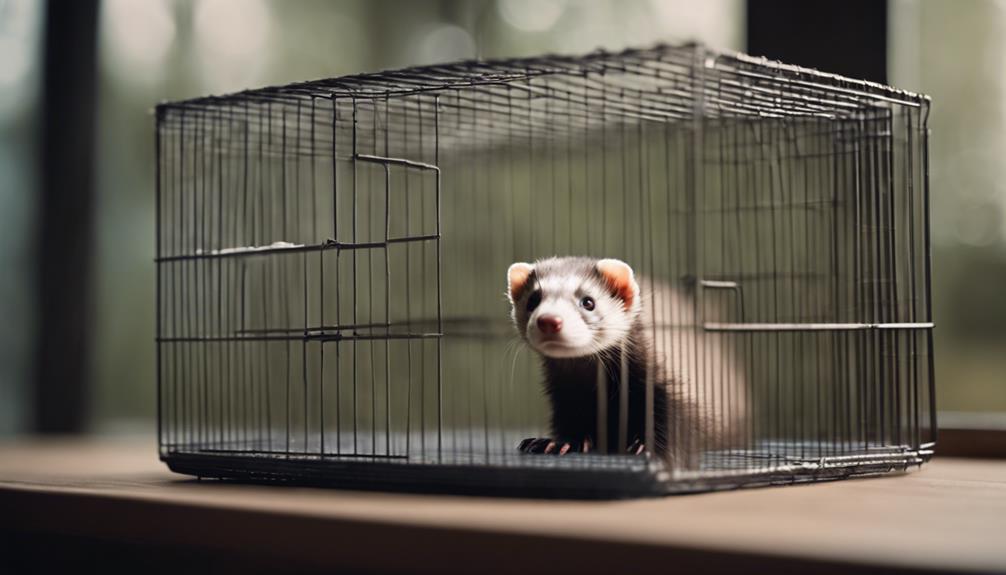
When constructing DIY ferret cages, it's crucial to prioritize material durability to ensure longevity and safety for the pets.
Designing the cage to be escape-proof is essential to prevent any potential harm or loss of the ferrets.
Adequate ventilation and airflow must also be considered to maintain a healthy environment within the cage.
Material Durability Concerns
Ensuring the material durability of DIY ferret cages is essential for maintaining a safe environment for your pets. When considering durability concerns, it's important to choose materials that can withstand the activities of ferrets, such as chewing and scratching.
Construction challenges may arise when selecting materials that balance durability with safety. Opting for sturdy materials like galvanized steel wire mesh or solid wood can help prevent escape attempts and ensure the longevity of the cage.
Avoid materials that may splinter or break easily, as these pose risks to your ferret's well-being. By addressing construction challenges and prioritizing durability, you can create a secure and long-lasting DIY ferret cage that provides a safe habitat for your furry companions.
Escape-Proof Design Essentials
Addressing escape-proof design essentials in DIY ferret cages requires careful consideration of safety aspects to safeguard your pets' well-being. Design innovation plays a crucial role in escape prevention, ensuring that your ferrets stay secure within their habitat. DIY advantages come into play, offering budget-friendly options for pet owners seeking custom solutions. When constructing a ferret cage, focus on sturdy materials, secure locks, and narrow bar spacing to prevent escapes. Including multiple levels and platforms not only enhances the cage's design but also provides mental stimulation for your ferrets. By incorporating these escape-proof design essentials, DIY ferret cages can offer a safe and secure environment for your beloved pets.
| Safety Aspects | Importance |
|---|---|
| Sturdy Materials | Ensures durability |
| Secure Locks | Prevents escape |
| Narrow Bar Spacing | Enhances safety |
Ventilation and Airflow
Proper ventilation and airflow are essential considerations when designing DIY ferret cages to ensure a healthy and comfortable environment for your pets. To optimize air circulation and improve ventilation in your DIY ferret cage, consider the following:
- Install a ventilation fan: Incorporating a small fan in the cage can help maintain proper airflow and reduce stuffiness.
- Create additional air vents: Making DIY modifications to add more vents can enhance fresh air intake and prevent any build-up of odors or ammonia.
- Adjust cage design for airflow: Simple tweaks like raising the cage slightly off the ground or adding mesh walls can promote better airflow within the enclosure.
Materials Needed for DIY Cages
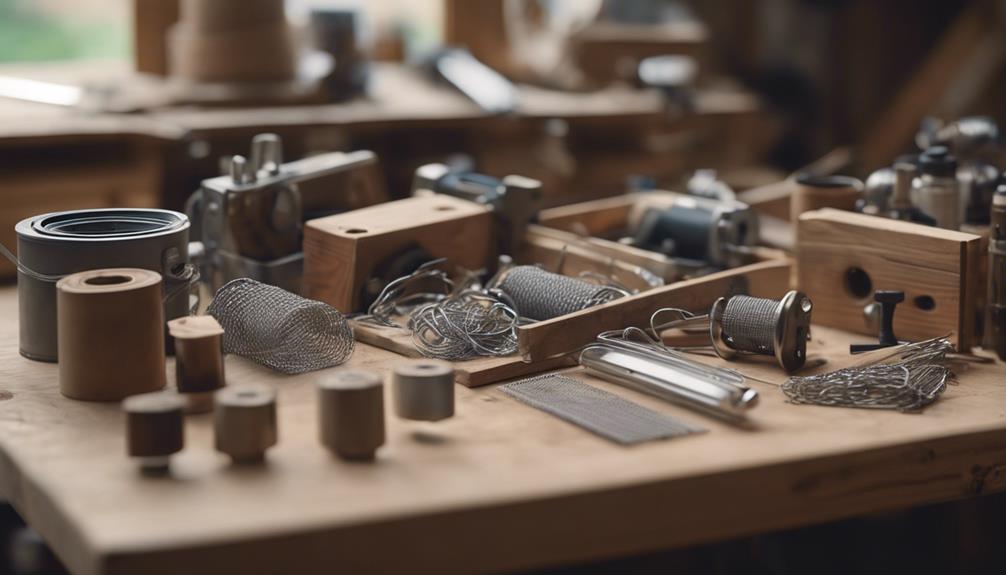
To construct a DIY ferret cage, gather essential materials such as wire mesh, wooden planks, door hinges, and latches. These items are crucial for providing a safe and secure environment for your ferrets. Here is a breakdown of the materials needed when building your own ferret cage:
| Materials | Description | Purpose |
|---|---|---|
| Wire Mesh | Sturdy metal mesh with small gaps | Provides ventilation and visibility |
| Wooden Planks | Strong, untreated wood planks | Forms the structure of the cage |
| Door Hinges | Durable metal hinges for the cage door | Allows easy access for cleaning |
| Latches | Secure closures for the cage door | Ensures the ferrets stay inside safely |
When selecting materials, ensure they are ferret-safe, sturdy, and escape-proof. DIY cage building tips include measuring twice before cutting, sanding down any rough edges to prevent injuries, and using non-toxic materials. By gathering these materials and following best practices, you can create a comfortable and secure DIY ferret cage for your furry friends.
Maintenance Requirements
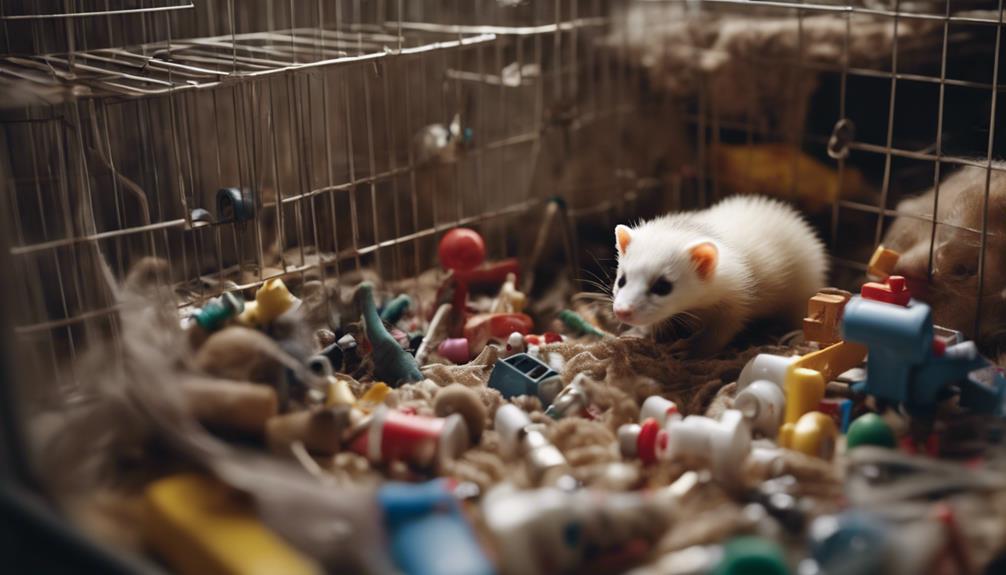
When maintaining a DIY ferret cage, regular cleaning and inspection of the materials are essential to ensure the safety and well-being of your ferrets. DIY cage cleaning involves removing waste, replacing bedding, and sanitizing surfaces to prevent the buildup of bacteria and odors. Additionally, DIY cage design should prioritize ease of cleaning and durability to withstand the wear and tear of ferret activities.
Here are three key maintenance requirements to keep in mind:
- Regular Cleaning Schedule: Establish a routine to clean the cage at least once a week to maintain a hygienic environment for your ferrets.
- Material Quality: Opt for easy-to-clean materials such as plastic or metal that can withstand frequent cleaning without deteriorating.
- Inspect for Wear and Tear: Regularly check the cage for any signs of damage or loose parts that could pose a risk to your ferrets' safety.
Suitability for Ferret's Needs
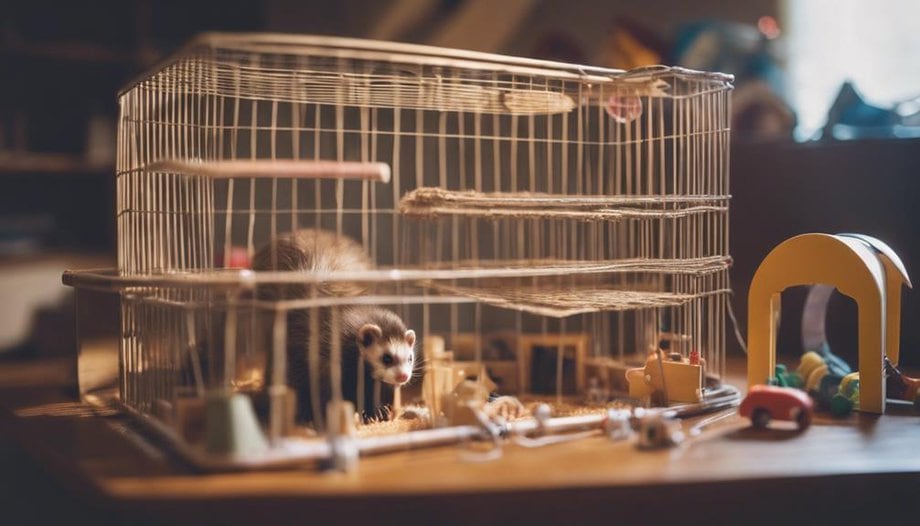
For ferrets to thrive in a DIY cage, ensuring that the setup meets their specific needs is crucial. When comparing DIY cages to store-bought ones, DIY cages offer the advantage of customization. This customization allows owners to tailor the cage to their ferret's preferences, incorporating multiple levels for climbing, various hiding spots for security, and tunnels for exploration.
However, DIY cage challenges can arise, such as ensuring the materials used are safe for ferrets, providing adequate ventilation, and securing the cage to prevent escapes. Additionally, DIY cages may require more maintenance to uphold cleanliness and structural integrity compared to commercial options.
It's essential to consider the ferret's needs when designing a DIY cage, including space for exercise, areas for rest, and enrichment opportunities to prevent boredom. By carefully addressing these aspects, DIY cages can indeed offer a suitable housing alternative for ferrets, providing a personalized and engaging environment for these curious pets.
Comparison With Commercial Cages

While DIY ferret cages offer customization advantages, comparing them with commercial cages reveals distinct differences in terms of convenience and overall quality.
When considering a commercial cage versus a DIY option for ferrets, here are some key points to keep in mind:
- Durability Comparison: Commercial cages are often made with sturdy materials designed to withstand the wear and tear of active ferrets, ensuring longevity and safety for your pets.
- Customizability Benefits: DIY cages allow for personalized touches and modifications to cater specifically to your ferret's needs and your preferences, offering a unique living space that suits your style.
- Cost Efficiency and Creativity Potential: While commercial cages may come at a higher price point, DIY options can be more cost-effective and provide an outlet for creativity, allowing you to create a cage that's both functional and visually appealing.
Considering these factors can help you decide whether a commercial cage or a DIY option is the best fit for your ferret's needs.
Frequently Asked Questions
Can DIY Ferret Cages Be Easily Disassembled and Moved to a Different Location?
Portable options for DIY ferret cages can often be easily disassembled and moved to a different location. With customizable designs, owners can create cages that suit their needs and preferences while maintaining the convenience of relocation.
How Long Does It Typically Take to Build a DIY Ferret Cage From Scratch?
Building a DIY ferret cage from scratch typically takes around 6-8 hours. The time commitment can vary based on complexity and skill level. Materials needed include wire mesh, wood boards, screws, and hinges for a secure and comfortable enclosure.
Are There Any Specific Design Features That Are Important to Consider When Building a DIY Ferret Cage?
When building a DIY ferret cage, it's crucial to consider materials for durability, ventilation for air circulation, size for ample space, and accessibility for cleaning. Prioritizing these design features ensures a safe and comfortable environment for ferrets.
Can DIY Ferret Cages Be Easily Expanded or Modified as the Ferret's Needs Change?
When considering DIY ferret cages, it's essential to evaluate their expansion options and customization possibilities. These cages offer space efficiency and flexibility in design, allowing for modifications as the ferret's needs change over time.
Are There Any Potential Legal Restrictions or Regulations to Be Aware of When Building a DIY Ferret Cage?
When building DIY ferret cages, individuals should be cognizant of local safety regulations regarding building materials, wire mesh spacing, and overall construction. Adhering to these guidelines ensures a secure environment for pet ferrets.











